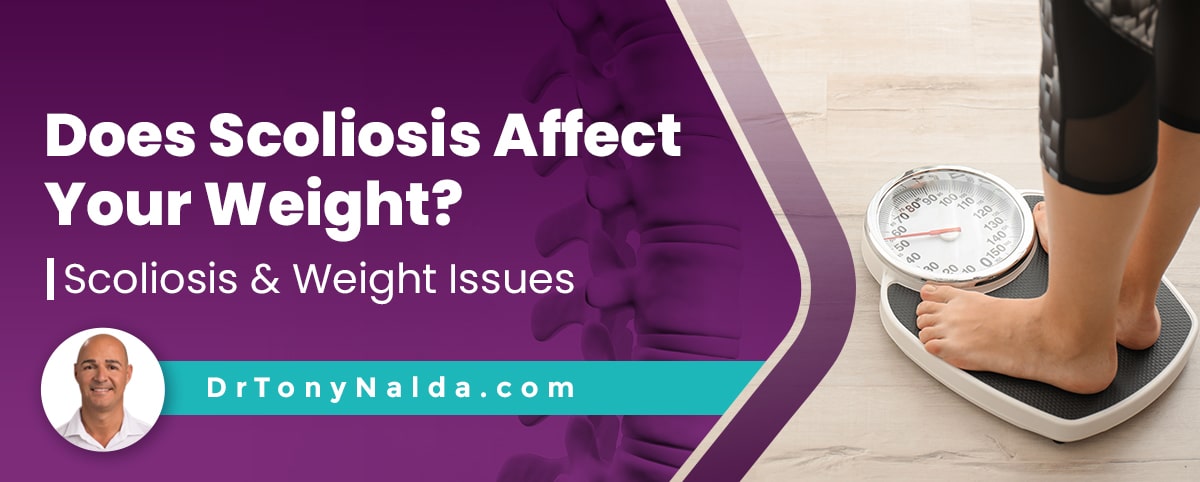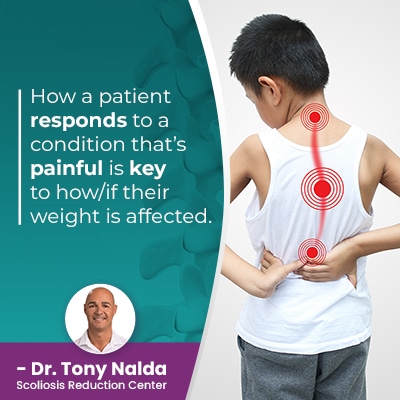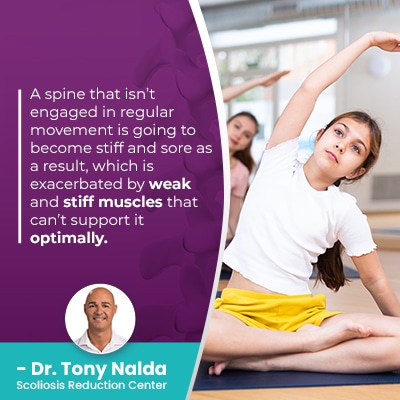Does Scoliosis Affect Your Weight? Scoliosis & Weight Issues

Each patient is affected by scoliosis in their own way; patient-experience is closely tied to the symptoms caused by their condition, and symptoms are shaped by a number of variables from patient age to condition type and severity. While some patients might experience weight gain due to activity restrictions, others can find their scoliosis has made them more committed to a fitness regime that leads to weight loss.
The connection between scoliosis and weight loss/weight gain appears to be more indirect, than direct. Certain symptoms (pain and mobility issues) can cause a patient to respond in a way that leads to weight gain, but that’s more about patient-response, than a direct effect of the condition.
There are studies that have found connections between weight, scoliosis, and scoliosis onset, so let’s start there.
Table of Contents
Being Underweight and Scoliosis Onset: What Do the Studies Say?
While most topics of how a condition affects weight center around the dangers of obesity; in the context of scoliosis, some studies indicate a connection between low body mass index (BMI) and the onset of adolescent idiopathic scoliosis (AIS).
BMI calculates body fat based on an individual’s height and weight.
While there are different types of scoliosis, adolescent idiopathic scoliosis, diagnosed between the ages of 10 and 18, is the condition’s most-prevalent form.
The idiopathic designation means we don’t fully understand the condition’s etiology, but we do know how to treat it effectively.
As scoliosis is the leading spinal condition amongst school-aged children, one Korean study attempted to address the increasing prevalence of AIS in elementary school-aged children.
The study focused on body composition, including weight, height, and spinal structure, and found that children considered underweight had a significantly higher rate of scoliosis.
The thought is that a lower BMI means less muscle mass, and as we know it’s not just the spine that has to maintain its natural curves and alignment, but also the spine’s surrounding muscles, it makes sense that a weaker musculoskeletal system could play a role in the onset of AIS.
Based on this study, there’s a strong connection between low weight and the onset of idiopathic scoliosis in children, and as we know that low body weight also affects bone density, the effects of reduced bone density and a weak musculoskeletal system can increase the chances of developing scoliosis.
So is there a connection between weight and scoliosis onset? According to the aforementioned study, there is indeed a connection, or at the very least, a need to conduct further research on the subject.
Now that we’ve addressed the topic of weight and scoliosis development, let’s now address the question of how/if scoliosis can cause weight gain/loss.
Does Low Body Weight Cause Scoliosis, or Vice Versa?
To turn to another study, the connection between altered body composition that’s present before the onset of scoliosis is explored; this study determined altered body composition by combining fat and lean mass as components of body weight.
The study also explored the association between leptin deficiency in AIS, and this is important because leptin is secreted from the body’s fat cells and is a hormone that regulates fat storage and caloric consumption.
The question is, does scoliosis cause adolescents to become underweight, or does being underweight contribute to the condition’s onset?
The study’s findings suggest that scoliosis doesn’t cause low body weight in adolescents, but that low body weight is an increased risk factor for scoliosis.
So what do these studies indicate? They show a connection between weight, musculoskeletal health, hormone levels, bone density, and the onset of clinically-detectable adolescent idiopathic scoliosis.
Now, let’s talk about that indirect connection I mentioned earlier, that can make some scoliosis patients gain, or lose, weight.
Scoliosis and Weight Management
So based on some important studies, there appears to be a connection between weight and scoliosis development, but what about those living with the condition? Will they gain weight, lose weight? How should weight be managed alongside scoliosis?
As a progressive and incurable condition, scoliosis does have it in its nature to worsen over time, and as patients have it for life, it’s natural to wonder how the condition can affect a person’s weight over time.
As stated earlier, I believe that the connection between weight gain/loss and scoliosis is more indirect, than direct, and this is why: if scoliosis is causing adverse symptoms such as pain that increases with mobility, the way a patient responds is key.
That patient can decide to work proactively to increase core strength so their spine is more optimally supported, and because stronger muscles are less likely to become sore, strained, and unbalanced, or they can decide to move less to avoid related discomfort.
 How a patient responds to a condition that’s painful is key to how/if their weight is affected.
How a patient responds to a condition that’s painful is key to how/if their weight is affected.
Scoliosis Pain and Mobility Issues
Remember, there is no clear description of what it feels like to have scoliosis, including no one set of symptoms that patients are guaranteed to experience, because scoliosis ranges so widely in severity, not to mention the fact that there are also different condition types a patient can develop.
In severe conditions, there is more likely to be pain, mobility issues, and related activity restrictions, so these patients are most at risk for falling into a sedentary lifestyle, quite simply, because it can make them feel better in the short term; however, the very design of the spine is based on movement, so that type of response can do more harm than good.
What one patient experiences, in terms of symptoms, isn’t necessarily indicative of what others will face.
There are also many different factors that shape how a person experiences scoliosis in their daily lives: patient age, overall health and fitness, and the chosen treatment approach.
So, based on my experience, does scoliosis directly cause my patients to gain or lose noticeable amounts of weight? No, it does not, however, I do think that scoliosis can cause residual effects that can elicit a patient-response that can lead to weight gain/loss.
Indirect Connections: Scoliosis Symptoms and Weight Gain/Loss
With the majority of my AIS patients, because the condition is not yet compressive, pain isn’t common, and functional deficits are also rare in mild and moderate scoliosis; even some cases of severe scoliosis can produce subtle symptoms that not everyone is going to notice.
So as pain, mobility issues, and functional deficits aren’t a common part of the adolescent experience of scoliosis, mobility issues aren’t a big concern; for young patients who are in good shape and are undergoing proactive treatment, weight gain is unlikely to be an issue.
But in patients with severe forms, and who might not be in good shape, and especially in those not undergoing treatment, pain/mobility issues can cause a response that leads to weight-management concerns.
In fact, patients who are active and maintain a healthy weight and activity level, can continue maintaining that after a scoliosis diagnosis, even though some associate scoliosis with a sedentary life of limitations: not accurate, of course.
While some activities and sports need to be approached with caution by people with scoliosis, there are strong correlations between staying fit and active and treatment success.
For one, a person who’s not carrying excess weight is actually easier to diagnose for the simple reason that it’s easier to see their spine, and in addition, a healthy weight means a healthier body, and this makes patients better able to handle the rigors of treatment.
As a condition progresses, the spine becomes less flexible and more rigid, making it less responsive to treatment, and in these types of cases, work has to be done prior to starting the typical course of treatment to first establish a baseline level of spinal flexibility.
Active people, whether they have scoliosis or not, are generally more flexible, and movement keeps the muscles strong and loose, and this means they are better able to support and stabilize the spine.
 A spine that isn’t engaged in regular movement is going to become stiff and sore as a result, which is exacerbated by weak and stiff muscles that can’t support it optimally.
A spine that isn’t engaged in regular movement is going to become stiff and sore as a result, which is exacerbated by weak and stiff muscles that can’t support it optimally.
For adolescents with severe conditions and who are overweight going into a diagnosis, they are more likely to experience pain and related mobility issues, and how they respond to this is key; adolescents who see the merits of increasing strength and activity levels can be motivated to make improvements that can lead to weight loss, while others who respond with inactivity are more likely to experience weight gain.
As scoliosis is compressive once skeletal maturity has been reached, which is when it tends to become painful, it’s also more likely that these issues are part of adult scoliosis than adolescents, for whom the condition is not yet compressive (the main cause of condition-related pain).
Conclusion
Despite the number of studies on the subject, the connection between scoliosis and weight gain/loss remains unclear.
While there seems to be a stronger link between low weight and scoliosis onset, how living with scoliosis can affect weight is less apparent and seems to be guided by scoliosis symptoms, and how a patient responds to them.
Because scoliosis ranges so widely in severity from mild to moderate and severe to very severe, body changes found in one patient can be the opposite in another.
When it comes to adolescents versus adults, the latter age group is more likely to face the indirect complication of weight gain; this is because pain and mobility issues are more common in older patients for whom the condition is compressive.
The more severe a condition, the more likely it is to cause noticeable symptoms, so depending on the types of symptoms, and how severe they are, the way a patient responds can lead to residual weight gain/weight loss.
In addition, how a diagnosis is responded to, in terms of treatment, is an important factor; those who opt for traditional treatment will spend a lot of time watching and waiting, while those who choose a proactive conservative approach will start treatment as close to the time of diagnosis possible.
As conservative treatment works by impacting the condition on every level, this means integrating multiple forms of condition-specific treatment: chiropractic care, in-office therapy, corrective bracing, and rehabilitation.
Increasing core strength is key to my approach, and this means using the power of scoliosis-specific exercises (SSEs) for increased spinal support; this means patients are getting stronger through treatment.
A conservative approach is also referred to as a functional approach because it strives to preserve as much of the spine’s natural function as possible, meaning keeping it strong, loose, and flexible to facilitate a wide range of motion; this approach is less likely to involve activity restrictions, and guidance on how to maintain a scoliosis-friendly lifestyle throughout treatment and beyond is another facet of treatment here at the Scoliosis Reduction Center.
Dr. Tony Nalda
DOCTOR OF CHIROPRACTIC
After receiving an undergraduate degree in psychology and his Doctorate of Chiropractic from Life University, Dr. Nalda settled in Celebration, Florida and proceeded to build one of Central Florida’s most successful chiropractic clinics.
His experience with patients suffering from scoliosis, and the confusion and frustration they faced, led him to seek a specialty in scoliosis care. In 2006 he completed his Intensive Care Certification from CLEAR Institute, a leading scoliosis educational and certification center.
About Dr. Tony Nalda
 Ready to explore scoliosis treatment? Contact Us Now
Ready to explore scoliosis treatment? Contact Us Now





